Physical Address
304 North Cardinal St.
Dorchester Center, MA 02124
Viral infections are a concern to practitioners in prenatal diagnosis, particularly in the interpretation of an abnormal fetal ultrasound examination.
It must be emphasized that the risks of transplacental transmission and fetal damage are pathogen- and gestation-specific.
An optimal approach requires understanding of:
the expected teratogenicity of infection;
its potential appearance on ultrasound;
the dynamics of the progress of maternal–fetal infection;
the anticipated progression of the disease and its symptoms.
There are three main reasons why infection needs to be considered in a pregnant woman:
Maternal exposure to an infectious pathogen.
Finding sonographic markers of fetal infection during a routine ultrasound scan.
Symptomatic maternal infection.
Raising the question of a possible intrauterine infection in the face of an ultrasound feature or group of features should prompt a series of investigations starting with the woman's serological status. At this stage, the only serological profile which allows exclusion of an infection as the possible cause of the sonographic features is that of negative IgM and negative IgG ( Figure 6-1 ).

All other serological profiles will require further virological and immunological assessment, for example:
The presence of isolated IgM is not suggestive of a seroconversion if this is not followed by the appearance of IgG within 2 weeks.
The presence of isolated IgG could either mean that the infection occurred before the current pregnancy or during the pregnancy, although long enough ago for the IgM to disappear.
In the presence of isolated IgG there are two ways of determining the likely onset of an infection in relation to the start of pregnancy. One is to test a previous sample; preferably a booking sample, however when this cannot be obtained, measuring the IgG avidity allows dating of the infection as older than 3 months or within 3 months of testing.
It is well known that antibodies bind less avidly (tightly) to antigens during the early stages of infection and this observation forms the basis of an avidity test. An avidity test result of <30% indicates infection within the preceding 3 months, whilst a measured avidity of >40% indicates infection more than 6 months earlier. This test may help to distinguish between primary infection and reactivation/reinfection by dating the infection as older than or within 3 months of testing.
When the onset of viral infection can be documented during the pregnancy with the appearance of IgG, usually following that of IgM, transplacental passage can take up to 6 weeks to occur and prenatal diagnosis by recovering the virus from the amniotic fluid is only reliable when fetal diuresis is well established and therefore usually not before 20 weeks’ gestation.
It is very important to remember that:
detection of a virus alone does not always mean fetal damage;
fetal infection does not always lead to the fetus being affected;
a negative result does not completely exclude the possibility of fetal infection.
The most prevalent congenital viral infection is cytomegalovirus (CMV) and this is also the infection which produces the richest semiology on prenatal ultrasound.
Cytomegalovirus (CMV), is a member of the herpes-viridae family and it is the commonest cause of congenital viral infection, affecting 1% of all pregnant women. Around 50% to 85% of all women are immune by childbearing age in most industrialized countries. Congenital CMV is mainly related to primary maternal infection. The risk of vertical transmission is 40% in the first and second trimesters of pregnancy and fetal damage occurs in about 10% of these cases. Transmission occurs in about 80% of cases in the third trimester but it is usually asymptomatic after 27 weeks of gestation. Although immunity to CMV is not entirely protective of vertical transmission, in cases with secondary infection the transmission rate is assumed to be 2–3%.
Maternal infection is usually asymptomatic, or presents as general malaise, fever, pharyngitis and lymphadenopathy. The incubation period is 4–8 weeks. Viraemia occurs 2–3 weeks after infection.
Symptomatic (10%)
50% will have typical features of CMV inclusion disease;
50% will have atypical features.
Asymptomatic 90%
These infants though infected at birth will have no symptoms.
The overall risk of damage in fetuses infected as a result of primary maternal infection is about 25%. The earlier the fetus is affected the more severe the disease tends to be. Children with congenital CMV infection following first-trimester infection are more likely to have central nervous system sequelae, especially sensorineural hearing loss.
Symptomatic infected newborns present with at least one of these abnormalities:
Prematurity.
Petechiae/purpura, thrombocytopenia, haemolysis.
Conjugated hyperbilirubinemia/jaundice, hepatosplenomegaly, elevated alanine aminotransferase levels (>80 UI/L).
Neurological findings (microcephaly, hypotonia, seizures) and increased cerebrospinal fluid proteins.
Symptomatic CMV inclusion disease (ID) has a mortality rate of around 6%.
Long-term follow-up of the 10% of children who are infected at birth has shown that in 90% of the subjects in this subgroup there will be at least one sequela such as:
psychomotor delay (70%);
sensorineural hearing loss (SNHL) (50%);
ocular abnormalities (mainly chorioretinis) (54%).
Asymptomatic neonates are known to have a better long-term prognosis with 10% to 15% developing sequelae (mainly SNHL) usually within the first 2 years of life.
CMV congenital infection is likely to be the cause of one third of all SNHL in childhood. Antiviral treatment of neonates showing SNHL leads to improved audiologic performance.
Since infection in a healthy mother with normal immunity is frequently asymptomatic, testing for CMV during pregnancy is usually precipitated by the discovery of a fetal marker during a routine ultrasound examination. If CMV infection of the fetus is suspected, the maternal infection status needs to be established initially. Once primary infection or reactivation of maternal CMV is confirmed, prenatal diagnosis can be offered to determine the risk of fetal infection.
A wide range of sonographic abnormalities has been associated with CMV infection. However the diagnostic accuracy of prenatal ultrasound alone to diagnose fetal infection is only around 25% and this is similar for symptomatic and asymptomatic forms of infection based on neonatal outcome. This is mainly due to the dynamic evolution of the infection and its corresponding but often subtle ultrasound features.
The natural history can be illustrated by the following sequence although features should be sought individually and the whole spectrum is rarely documented.
Placentitis appears as a thick and heterogeneous placenta with both hyper- and hypo-echoic areas ( Figure 6-2 ). Although it is difficult to define a cut-off thickness, any value above 40 mm in the second trimester can be considered a thick placenta.

Once the placenta can no longer act as a barrier against infection, the virus reaches the fetal circulation and its high affinity for renal tissue may cause fetal nephritis. Fetal nephritis may manifest as diffuse renal hyperechogenicity, but this is very unusual. The kidneys are usually normal sonographically but being affected may show transient dysfunction and therefore oligohydramnios. Replication of CMV in the fetal kidneys will allow the virus to be excreted in the fetal urine and hence the prenatal diagnosis to be made in the amniotic fluid.
When symptomatic acute systemic infection ensues, the following ultrasound features may be detected:
hepatomegaly;
splenomegaly;
hyperechogenic bowel ( Figure 6-3 );
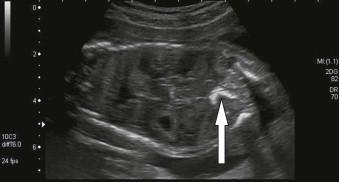
ascites;
calcification of the liver, the lungs and the myocardium. The calcific foci are usually parenchymal with infection;
oligohydramnios (see above).
Fetal liver measurements show quite a wide confidence interval but a 40 mm thickness between the gallbladder and the diaphragm measured either in a parasagittal plane or a frontal plane usually qualifies for hepatomegaly during the second and early third trimester.

Splenomegaly is measured in a transverse plane of the fetal abdomen limited by the lowest rib, the stomach bubble and the spine. A longest diameter of at least 40 mm during the same gestational window is compatible with splenic enlargement. Splenomegaly may produce a small stomach bubble, shifted somewhat towards the midline, and is often associated with increased amniotic fluid volume resulting from the compression of the stomach by the enlarged spleen and or liver.

Cardiomyopathy may be seen usually as part of hydrops fetalis related to either anaemia or generalized metabolic failure.
Hyperechogenic bowel is a subjective finding but in this context must be echogenic bowel as bright as bone (EBABAB). EBABAB may be due to meconium ileus. Meconium peritonitis may follow bowel perforation by the virus itself, this feature is often also transient ( Figure 6-6 ).

Hydrops in CMV infection usually presents with moderate ascites, and pleural and pericardial effusions. Skin oedema is usually mild. Hepatosplenomegaly and hyperechogenic bowel are usually present once the fetus is hydropic.
Fetal brain involvement is the main prognostic factor of fetal infection.
The intracranial findings include :
Signs of a ventriculitis:
ventriculomegaly;
ventricular septations;
echogenic ventricular rims ( Figure 6-7 A and B ).
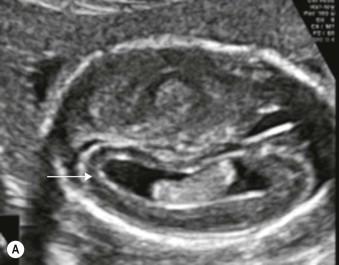
Periventricular hyperechogenicity, calcification or porencephaly all of which are a consequence of periventricular leukomalacia.
These intracranial features are often associated with hyperechogenicity and pseudocysts of the germinal matrix and neuronal migration abnormalities including polymicrogyria ( Figure 6-8 ).
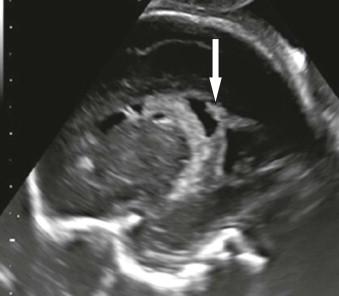
Cerebellar abnormalities often present as hyperechoic areas and cerebellar hypoplasia ( Figure 6-9 ).
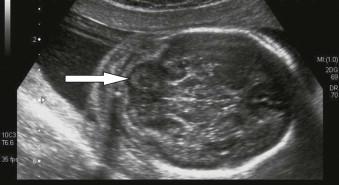
Microcephaly is the end result of brain atrophy and is usually associated with some or all of the above described signs.
Particular attention should be paid to the aspect and size of the pericerebral spaces, where a delay or lack of gyration of the main and secondary fissures and sulci and increased pericerebral spaces will be evident, particularly on coronal views ( Figure 6-10 ).
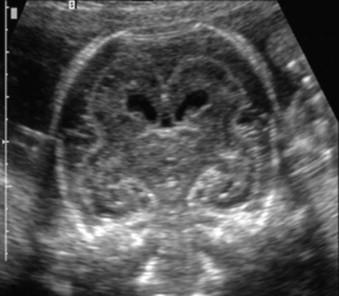
The ultrasound examination of the fetal brain in infected fetuses should comply with the requirements of a full neurosonogram examining both axial, coronal, sagittal and parasagittal planes searching for sometimes subtle features. However meticulous serial dedicated neurosonograms can be, it is advisable to perform fetal brain MRI in the third trimester of pregnancy since some features, especially migration and gyration abnormalities, will be better seen by MRI.
Growth restriction is described in up to half of symptomatic neonates but also in about a third of asymptomatic ones and this could be due either to placental insufficiency related to infection or else due to severe symptomatic fetal infection.
The use of invasive prenatal testing for CMV is based on amplification of the viral genome by polymerase chain reaction (PCR) in the amniotic fluid retrieved by amniocentesis.
Timing of amniocentesis is important in order to minimize the risk of false-negative results. Lower sensitivities are expected before 20 weeks and when the sample is performed less than 6 weeks following maternal infection. Despite appropriate timing, up to 8% of the neonates tested negative during pregnancy will be born with positive viruria. This is likely to reflect late transplacental passage and has not been associated with any developmental problem in the infected infants.
There is no role for fetal blood sampling and analysis in the diagnostic work-up of potential CMV infection. However fetal thrombocytopenia below 100,000/dL is an independent prognostic factor from fetal imaging and a complete prognostic assessment in the presence of confirmed fetal infection should include fetal blood analysis.
Become a Clinical Tree membership for Full access and enjoy Unlimited articles
If you are a member. Log in here